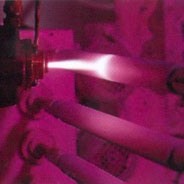




PROCESSES
 |
 |
 |
 |
 |
|||
| SUGGESTIONS | CATALOGUE | MATERIALS
& PROCESSES |
COMPANY | NEWS | CONTACTS | ||
|
|
|
CERAMIC PLASMA COATING | |||||||||||||||||||||||||||||||||||||||||||||||||||||||||
 |
GENERAL DESCRIPTION OF TREATMENT This is a ceramic coating to be used in all cases requiring a combination of resistance to wear of ceramic compounds with durability and resistance to impact typical of metals. The process envisages the use of a number of noble gases, which, via special jets, pass through an electric arc and ionise, giving rise to an enormously accelerated jet at 2000° C. A very fine particle ceramic powder is delivered to the plasma jet, which is melted and sprayed onto the part to be coated, on which it adheres and cools instantaneously. The part that undergoes this treatment remains at a temperature of approx. 80°C. The surfaces subject to plasma coating are pre-treated to obtain a specific macro-roughness to ensure anchoring of the ceramic coating. A specific preparation can also significantly increase adherence of the coating. |
|||||||||||||||||||||||||||||||||||||||||||||||||||||||||
|
|
||||||||||||||||||||||||||||||||||||||||||||||||||||||||||
| MECHANICAL PROPERTIES | Hardness – Resistance to abrasion – Resistance to wear | |||||||||||||||||||||||||||||||||||||||||||||||||||||||||
| COATING TYPES AND PROPERTIES |
|
|||||||||||||||||||||||||||||||||||||||||||||||||||||||||
| RESISTANCE TO CORROSION |
The ceramic coating is porous and therefore does not guarantee optimal resistance to corrosion per se. Where necessary, we can solve the problem by sealing off the porosity. |
|||||||||||||||||||||||||||||||||||||||||||||||||||||||||
| COMPATIBLE MATERIALS | All main types of metal materials can be coated. Our long-standing experience has achieved highly specialised skills in the field of metal wiring, also small gauge, as well as parts with round and flat forms. | |||||||||||||||||||||||||||||||||||||||||||||||||||||||||
| DIMENSIONS |
DIMENSIONAL CONSTRAINTS |
|||||||||||||||||||||||||||||||||||||||||||||||||||||||||